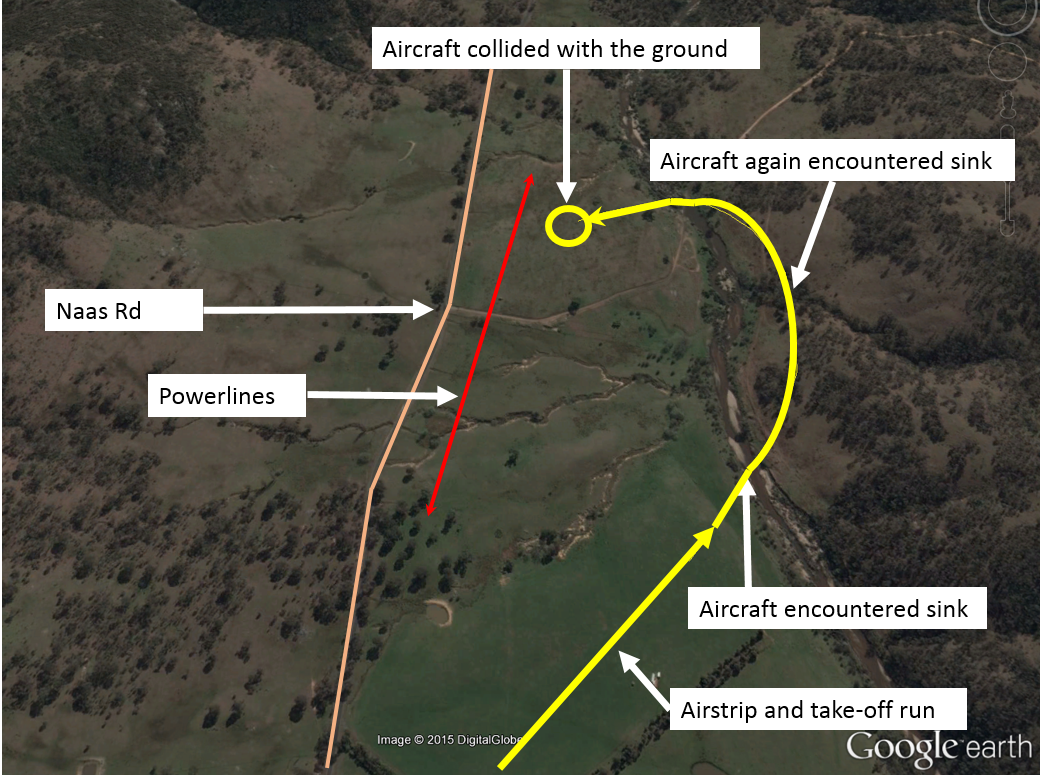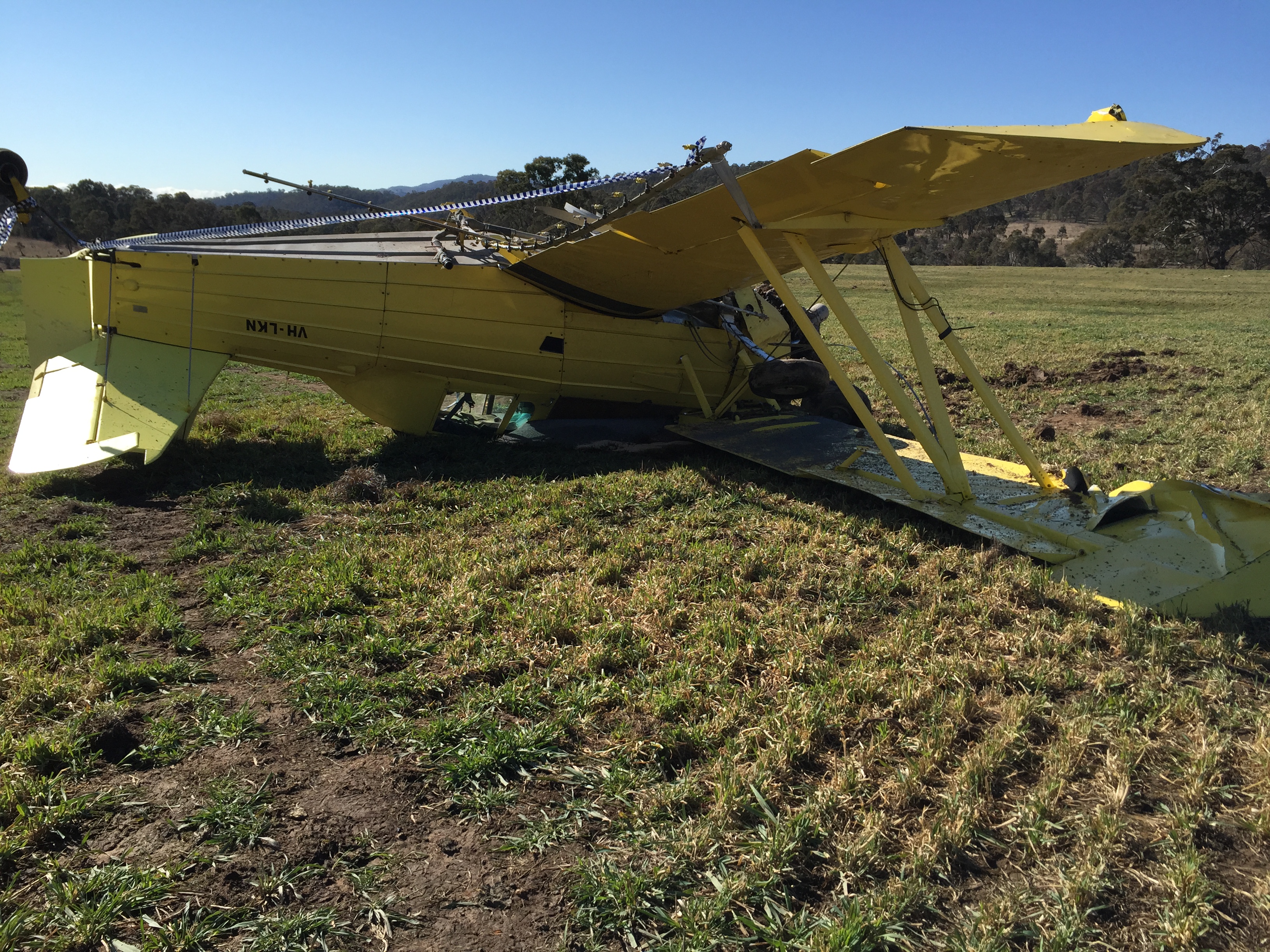What happened
On 6 August 2015, the pilot of a Grumman G164 aircraft, registered VH-LKN, was conducting aerial spreading of superphosphate on a property about 33 km south-west of Tharwa, Australian Capital Territory. The target zone for the spreading was about 7 km to the south-east, and at an elevation about 1,000 ft higher than the airstrip and loading site.
The pilot commenced operations at about 1000 Eastern Standard Time (EST) and completed spreading of six loads of superphosphate. The pilot then had a lunch break and refuelled the aircraft to a total of about 180 L of fuel. The aircraft was also loaded with about 500 kg of superphosphate, which was about half its carrying capacity. The pilot observed a light, westerly wind of about 2 to 5 kt in the vicinity of the airstrip.
At about 1400, the pilot commenced the take-off run for the seventh load of the day. As the aircraft became airborne, the aircraft started to sink (Figure 1). To stop the aircraft sinking, the pilot applied the dump lever to start dumping the load of superphosphate. The aircraft then started to climb, so the pilot stopped dumping the load. The pilot also commenced a shallow left turn, away from rising terrain. As the aircraft turned, when at about 100 ft above ground level, it started to sink again. As it sank, the pilot felt a shake through the airframe, indicating that the aircraft was close to stalling. The pilot re-applied the dump lever to open the hopper door and try to reduce the aircraft load. Simultaneously, the pilot lowered the aircraft’s nose and rolled the wings level, to try to recover from the incipient stall.
Figure 1: Departure airstrip, aircraft track and accident location
Source: Google earth and pilot recollection – annotated by the ATSB
The pilot sighted powerlines, a road and a row of trees ahead, beyond which the terrain rose steeply. The aircraft continued to descend and the pilot maintained the aircraft in a normal nose attitude for landing. As the aircraft neared the ground, the pilot reduced the throttle to idle and held the aircraft control stick in the full back position. The tailwheel struck the ground first, and then the right main landing gear dug into soft ground. The aircraft flipped over and came to rest inverted.
The pilot sustained minor injuries and the aircraft was substantially damaged (Figure 2).
Figure 2: Damage to VH-LKN
Source: Pilot
Pilot comments
The pilot provided the following comments:
- The airstrip was at an elevation of about 2,100 ft above mean sea level. The target pasture was about 1,000 ft higher than the airstrip.
- The airstrip was about 500 m in length and the fuel and chemical load was relatively light. The aircraft was well within its operational limitations.
- The weather forecast had indicated calm conditions, and the temperature was about 14°C.
- The sink that the aircraft encountered may have been a downdraft coming off the hill.
- If the airstrip had been higher up and closer to the target zone, the pilot would have had more time to dump the load, less distance to climb on each load, and a more accurate assessment of the wind conditions.
- Dumping liquid takes a few seconds, but granular substances like superphosphate take minutes for the hopper to empty when dumping the load.
- After the accident, the pilot verified that the hopper door was open, and superphosphate was present in the paddock, indicating that it had been dumping at the highest rate. Despite that, about 300 kg of superphosphate remained in the hopper.
Safety message
The pilot stated that the key to avoiding similar incidents was to understand the atmospheric conditions in steep mountainous country. Variations in wind strength and direction due to terrain can have serious consequences on flight safety, particularly when operating at low airspeeds and close to the ground.
ATSB investigated a similar accident involving a Grumman G-164A, in AO-2014-001.
Aviation Short Investigations Bulletin Issue 44
Purpose of safety investigationsThe objective of a safety investigation is to enhance transport safety. This is done through:
It is not a function of the ATSB to apportion blame or provide a means for determining liability. At the same time, an investigation report must include factual material of sufficient weight to support the analysis and findings. At all times the ATSB endeavours to balance the use of material that could imply adverse comment with the need to properly explain what happened, and why, in a fair and unbiased manner. The ATSB does not investigate for the purpose of taking administrative, regulatory or criminal action. TerminologyAn explanation of terminology used in ATSB investigation reports is available here. This includes terms such as occurrence, contributing factor, other factor that increased risk, and safety issue. Publishing informationReleased in accordance with section 25 of the Transport Safety Investigation Act 2003 Published by: Australian Transport Safety Bureau © Commonwealth of Australia 2015
Ownership of intellectual property rights in this publication Unless otherwise noted, copyright (and any other intellectual property rights, if any) in this report publication is owned by the Commonwealth of Australia. Creative Commons licence With the exception of the Coat of Arms, ATSB logo, and photos and graphics in which a third party holds copyright, this publication is licensed under a Creative Commons Attribution 3.0 Australia licence. Creative Commons Attribution 3.0 Australia Licence is a standard form licence agreement that allows you to copy, distribute, transmit and adapt this publication provided that you attribute the work. The ATSB’s preference is that you attribute this publication (and any material sourced from it) using the following wording: Source: Australian Transport Safety Bureau Copyright in material obtained from other agencies, private individuals or organisations, belongs to those agencies, individuals or organisations. Where you wish to use their material, you will need to contact them directly. |




